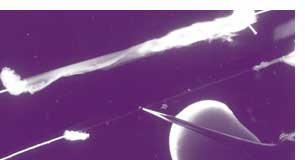 |
 |
|
 |
 |
 |
 |
 |
|
 |
 |
 |
 |

Squid Giant Axon Provides Clues to Nerve Cell Repair
Understanding how damaged cells heal may lead to treatment for spinal cord injuries and diseases of the nervous system
"Cellular repair is the fundamental first step in the repair of the nervous system," says Harvey Fishman, a biophysicist at the University of Texas Medical Branch, and summer investigator at the Marine Biological Laboratory. By studying how individual nerve cells naturally heal, Fishman’s research at the MBL is beginning to answer questions about why nerve repair is possible and how scientists may eventually augment the process.
Fishman has developed a model of nerve cell repair by studying the giant axon of the Woods Hole squid. The squid has a large nerve cell as thick as a pencil-lead that extends the entire length of its body. By injecting fluorescent dyes into the membrane of the squid axon, Fishman can visualize what occurs when a nerve is injured. The membrane of the axon near the injury shrinks in diameter as bubbles of membrane, called vesicles, break off from the area. The fluorescently labeled vesicles then travel to the injury site and plug the hole in the cell membrane.
According to Fishman, vesicles begin accumulating about an hour after a cell is damaged, eventually creating a complete barrier at the injury site. "It's like plugging a dike with your finger," he says.
Vesicles play another role in neuron repair. While healthy nerves can send electrical currents through their axons, damaged nerves are unable to carry these signals. Fishman tested damaged axons to see if vesicle formation at the site of an injury restored the function of the nerve. He found that vesicles created membrane continuity that allowed electrical activity to return. The whole process worked a lot like skin repair: when your finger is cut, a blood clot forms to protect the finger while new skin forms below the scab. Vesicles plug holes in nerve cells while a new membrane forms.
Fishman is now investigating how to forecast nerve cell survival after a spinal cord injury. He is also expanding his research to look at axon injury, repair, and survival in the neurons of mammals. Understanding these cell membrane repair processes may help lead to therapeutics that will prevent nerve cell damage or death. And this, along with an understanding of how vesicles form and aid in cell repair, may eventually help doctors treat spinal cord injuries and diseases that destroy the nervous system.
|
| |

 |
|
 |
 |
|